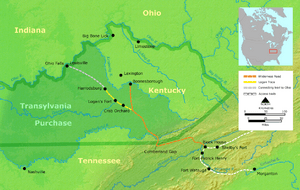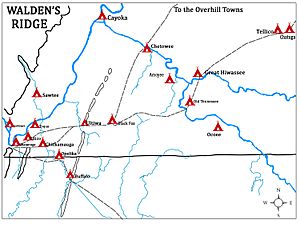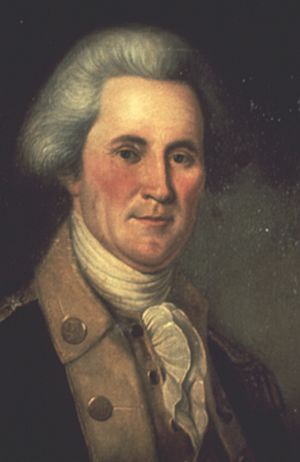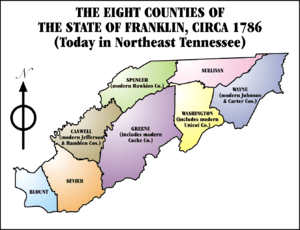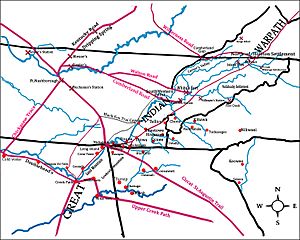Cherokee–American wars facts for kids

The Cherokee–American wars, also known as the Chickamauga Wars, were a series of fights between the Cherokee people and American settlers. These conflicts took place in the southern parts of what is now the United States, from 1776 to 1794. There were many small battles, ambushes, and larger fights.
A powerful Cherokee leader named Dragging Canoe led his warriors. They often fought alongside other Native American tribes like the Muscogee and the Shawnee. During the American Revolutionary War, they also teamed up with British soldiers and their allies. Their goal was to push the American colonists out of their lands.
The fighting started in the summer of 1776 in areas like East Tennessee, Virginia, North Carolina, South Carolina, and Georgia. It later spread to lands in Middle Tennessee and Kentucky.
These wars had two main parts. The first part, from 1776 to 1783, saw the Cherokee fighting with the Kingdom of Great Britain against the American colonies. The Cherokee War of 1776 involved the entire Cherokee nation. By the end of 1776, many Cherokee who wanted to keep fighting moved with Dragging Canoe to new towns. These warriors became known as the "Chickamauga Cherokee".
The second part of the wars lasted from 1783 to 1794. During this time, the Cherokee were supported by Spain against the new United States. These Cherokee moved west to new settlements and became known as the Lower Cherokee. The fighting ended in November 1794 with the Treaty of Tellico Blockhouse.
In 1786, Mohawk leader Joseph Brant helped create the Western Confederacy. This group of tribes resisted American settlers moving into the Ohio area. The Lower Cherokee were part of this group and fought in the Northwest Indian War. This larger war ended in 1795 with the Treaty of Greenville.
The end of these wars allowed settlers to move into lands that were once called "Indian territory." This led to the creation of new states like Kentucky in 1792 and Ohio in 1803.
Contents
- Before the Wars (1763–1775)
- Revolutionary War: Cherokee War of 1776
- Revolutionary War: Southern Strategy (1778–1783)
- British Victories in the North
- Battles in the Deep South
- Fort Nashborough
- Overmountain Area Fights
- Attacks at Chickamauga
- Chickasaw-American War
- Moving to the Lower Towns
- Cherokees in the North
- Georgia Indian War of 1782
- St. Augustine Meeting
- Overhill Politics
- Treaty of Paris (1783)
- Treaties with Chickasaw and Muscogee
- After the Revolution: New Paths (1783–1788)
- Cherokee Influence Grows (1788–1792)
- After the Revolution: The Watts Years (1792–1795)
- Aftermath
Before the Wars (1763–1775)
The French and Indian War (1754–1763) and the larger Seven Years' War in Europe set the stage for the conflicts between the Cherokee and American settlers. Tensions grew on the frontier, and open fighting began when the American Revolution started.
After the French and Indian War
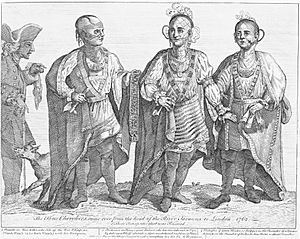
The French and Indian War included the Anglo-Cherokee War (1758–1761). British forces destroyed several Cherokee towns, which were never rebuilt. After this war, the Cherokee signed treaties with Virginia (1761) and South Carolina (1762). Attakullakulla, a pro-British Cherokee leader, became the First Beloved Man (Principal Chief).
After the Treaty of Paris (1763) ended the European war, the British tried to keep peace in the colonies. King George III issued the Royal Proclamation of 1763. This rule tried to stop colonists from settling west of the Appalachian Mountains. However, many colonists did not like this rule and ignored it.
Land Treaties and Sales
The British tried to settle land claims with Native American tribes. In 1768, the Treaty of Hard Labour was signed with the Cherokee. This treaty was supposed to keep Cherokee lands west of the Kanawha River.
But colonists kept moving onto Cherokee land. So, in 1770, another treaty, the Treaty of Lochaber, was signed. This treaty gave up more Cherokee land in what is now West Virginia and Kentucky. It also protected colonists living near the Holston River, in today's Tennessee-Virginia border area.
Early Settler Communities
The first colonial settlements in what is now Upper East Tennessee included Sapling Grove (Bristol). Other settlements grew along the Nolichucky River and in Carter's Valley. In 1772, settlers on the Watauga and Nolichucky rivers formed the Watauga Association to govern themselves.
These settlers thought they were in Virginia. When a survey showed they were on Cherokee land, they were told to leave. But Attakullakulla, a Cherokee leader, helped them stay. They were allowed to remain, but no new settlers could join them.
Boone's Group Attacked

In September 1773, Daniel Boone led a group of about 50 settlers through the Cumberland Gap into Kentucky, which was a hunting ground for many tribes. The Shawnee, Lenape, Mingo, and some Cherokee attacked a scouting party. Boone's son, James, and another young man were killed. The settlers gave up their plan to settle there. This led to Lord Dunmore's War in 1774, mainly against the Shawnee.
The Cherokee and Muscogee also carried out small raids on settlements in the Carolinas and Georgia.
Henderson's Land Deal (1775)
On March 17, 1775, a group of land buyers from North Carolina, led by Richard Henderson, made a deal with older Overhill Cherokee leaders. This was the Treaty of Watauga. The Cherokee leaders, including Oconostota and Attakullakulla, agreed to give up their claim to Kentucky lands. Henderson's group, the Transylvania Land Company, thought they now owned the land. However, other tribes like the Lenape, Shawnee, and Chickasaw also claimed these lands for hunting.
Dragging Canoe, a Cherokee leader and son of Attakullakulla, strongly disagreed with this deal. He warned the North Carolina men, "You have bought a fair land, but there is a cloud hanging over it; you will find its settlement dark and bloody." This warning made Kentucky known as the "dark and bloody ground." The governors of Virginia and North Carolina did not approve the treaty. The Cherokee asked John Stuart, the British Indian Affairs Superintendent, for help, but the American Revolution began.
Henderson and other frontiersmen believed the Revolution meant they no longer had to follow the royal governors' rules. The Transylvania Company started to recruit settlers. But in 1776, Virginia stopped further settlement, and in 1778, it declared the Transylvania deal invalid.
Revolutionary War: Cherokee War of 1776
During the Revolutionary War, the Cherokee fought against American settlers who were moving onto their lands. They also fought as allies of Great Britain against the American Patriots. The British mainly focused on the northern colonies, so the Cherokee mostly fought on their own, receiving supplies from British ports.
Loyalists Flee
As tensions rose, John Stuart, the British Superintendent of Indian Affairs, had to escape from a crowd in Charleston. He fled to St. Augustine in East Florida.
Another Loyalist, Thomas Brown, was attacked by a group called the Sons of Liberty in Georgia. After escaping, he joined the Seminole people and led his East Florida Rangers.
From St. Augustine, Stuart sent his deputy, Alexander Cameron, and his brother Henry to Mobile to get supplies and weapons for the Cherokee. Dragging Canoe and 80 warriors went to protect the supplies. He met Henry Stuart and Cameron in Mobile on March 1, 1776. Dragging Canoe asked how he could help the British against the rebels and with the illegal settlers. He was told to wait for British troops to arrive.
Henry Stuart sent letters to the frontier settlers, telling them they were illegally on Cherokee land and had 40 days to leave. People who supported the Revolution created a fake letter. It said a large force of British troops and other tribes were coming to attack. This fake letter scared the settlers, who then gathered in forts and prepared for an attack.
Northern Tribes Visit
In May 1776, the Shawnee chief Cornstalk led a group of northern tribes (Shawnee, Lenape, Iroquois) to meet with southern tribes (Cherokee, Muscogee, Chickasaw, Choctaw) at Chota. They discussed fighting together with the British against their common enemy, the American settlers. Cornstalk spoke about uniting against the "Long Knives" (settlers) who were taking land in Kentucky. Dragging Canoe agreed to join them.
To prepare for war, the Overhill Cherokee began raiding Kentucky, often with the Shawnee. Dragging Canoe led a small group into Kentucky and returned with scalps. In another raid, a group led by Hanging Maw captured three settler girls, including Jemima Boone, on July 14. But Daniel Boone and others rescued them three days later.
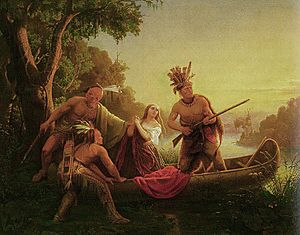
First Cherokee Attacks
In late June 1776, Cherokee war parties from the Lower Towns attacked settlements in South Carolina. On July 1, other Cherokee groups raided North Carolina. Traders warned the Overmountain settlers about the coming attacks from the Overhill Towns, thanks to Nancy Ward, a respected Cherokee woman. However, the Cherokee attacks did not go as planned.
On July 3, a small Cherokee group attacked a fort in North Carolina. The fort held out until a large group of militia arrived, forcing the Cherokee to retreat.
A group of 190 Cherokee and Loyalists attacked Lindley's Station in South Carolina. The fort's 150 Patriot defenders had just finished building it. The Patriots fought back, killing two Loyalists and capturing ten, but no Cherokee were killed.
Dragging Canoe's forces advanced and had a small fight with 20 militia members, who quickly left. On July 20, his force met a larger group of militia near Fort Lee. In the "Battle of Island Flats," Dragging Canoe was shot in the hip, and his brother Little Owl was also hit many times but survived. His force then pulled back, raiding cabins on their way back to the Overhill area.
On July 21, another Cherokee group tried to capture Fort Caswell but was driven back with many losses. They then tried to besiege the fort, but gave up after two weeks.
Moving to Chickamauga
Oconostota wanted peace with the colonists. Dragging Canoe wanted to send women, children, and elders to safety, burn the towns, and ambush the Virginians. Oconostota and other older chiefs disagreed. Oconostota even offered to trade Dragging Canoe and Cameron to save the Overhill Towns.
Dragging Canoe spoke to the council, saying the older leaders were giving up too much land. He declared, "As for me, I have my young warriors about me. We will have our lands." After this, he and other strong leaders, including Ostenaco, gathered like-minded Cherokee from different towns. They moved to what is now the Chattanooga, Tennessee area. This area was where the Great Indian Warpath crossed the Chickamauga River. Because Dragging Canoe made this his base, Americans called his group the "Chickamaugas." Other Cherokee refugees went to Pensacola for the winter.
John McDonald, a trader, already had a post there, linking them to Henry Stuart in Pensacola. Cameron, the British deputy Indian superintendent, also joined Dragging Canoe. Most white people who lived among the Cherokee also left with them.
In March 1777, Cameron sent supplies to the refugees at Chickamauga. The colonists learned of this and planned to stop the supplies. Emistisigua, a chief of the Upper Muscogee, sent 350 warriors to protect the supplies and help rebuild and fight.
Treaties of 1777
The Overhill Towns and Virginia held peace talks in April 1777. The Cherokee signed the Treaty of Dewitt's Corner with Georgia and South Carolina on May 20, and the Treaty of Fort Henry with Virginia and North Carolina on July 20. They promised to stop fighting, and the colonies promised to protect them. In the Treaty of Dewitt's Corner, the Lower Towns gave up almost all their land in modern South Carolina.
Cherokee Targets
From their new bases, the Cherokee raided settlers on the Holston, Doe, Watauga, and Nolichucky rivers, and on the Cumberland and Red rivers. They also attacked travelers on the Tennessee River and on old trails like the Great Indian Warpath. Later, they targeted roads built by settlers, such as the Kentucky and Cumberland roads. Sometimes, they attacked places in Virginia, the Carolinas, Georgia, Kentucky, and Ohio.
In 1777, Dragging Canoe led a war party that killed a settler and stole horses. They also killed David Crockett's grandparents and other children near modern Rogersville, Tennessee.
In summer 1777, Cameron and Taitt led a large group of Cherokee and Muscogee warriors against settlements in the Carolinas and Georgia. The Cherokee set up a camp near the Tennessee and Ohio Rivers to stop people from entering the Mississippi area in 1778.
Revolutionary War: Southern Strategy (1778–1783)
In late 1778, the British focused their war efforts on the southern colonies. This meant more British armies and supplies, including those for the Southern Native Americans. The southern colonies also had more Loyalists. With these new advantages, the Cherokee were able to defend their lands more strongly. Both the Cherokee and the Upper Creek tribes actively joined the fight.
British Victories in the North
On December 17, 1778, Henry Hamilton captured Fort Vincennes. He planned to gather 500 warriors from various tribes, including the Cherokee, to push back George Rogers Clark's forces. McDonald's base at Chickamauga was to be a supply point for the Cherokee and Muscogee. However, Clark recaptured Fort Vincennes on February 25, 1779. After this, the Chickamauga Cherokee turned their attention to the northeast.
Battles in the Deep South
The British captured Savannah on December 29, 1778, with help from Dragging Canoe, John McDonald, and Cherokee and Muscogee forces. They also captured Augusta, Georgia, on January 31, 1779, but had to retreat quickly. These victories led more neutral Muscogee towns to join the British side.
Charleston was captured on May 12, 1780. The British took about 3,000 Patriots prisoner.
Fort Nashborough
In early 1779, James Robertson and John Donelson traveled overland and founded Fort Nashborough on the Cumberland River. This was the first of many settlements in the Cumberland area, which then became a target for Native American attacks.
Donelson traveled down the Tennessee River with his family, aiming for Fort Nashborough. They left East Tennessee on February 27, 1780. They faced several ambushes. Near Tuskegee Island on March 7, Cherokee warriors attacked their boat. The Cherokee captured one survivor, but this victory was costly for them, as smallpox spread among their people, killing hundreds. The Donelson group finally reached Fort Nashborough on April 24, 1780.
Overmountain Area Fights
Robertson received a warning from Chota that Dragging Canoe's warriors would attack the Holston area. Small Cherokee raids on the Holston frontier began soon after.
In summer 1780, Thomas Brown planned a meeting between the Cherokee and Muscogee to coordinate attacks. But Georgians under Elijah Clarke tried to retake Augusta in September, where Brown had his headquarters. A large group of Chickamauga and Overhill Cherokee, along with forces from South Carolina, prevented Augusta's capture. The Cherokee and Brown's rangers chased Elijah Clarke's army, causing damage to rebel settlements. This led to the Battle of Kings Mountain on October 7, 1780. In this battle, American frontiersmen defeated Loyalist militia.
Brown urged Dragging Canoe and other Cherokee leaders to attack the settlements while many American men were away. The Overhill Towns fully supported this new attack. However, Patrick Ferguson's defeat at Kings Mountain surprised them.
Nancy Ward again warned Virginia Governor Thomas Jefferson about the invasion. Jefferson sent an expedition of 700 Virginians and North Carolinians, led by John Sevier, against the Cherokee in December 1780. This expedition defeated a Cherokee war party at the Battle of Boyd's Creek on December 16.
After this battle, Sevier's army joined forces with Arthur Campbell and Joseph Martin. They marched against the Overhill towns, burning seventeen of them, including Chota, Chilhowee, and Tellico, by January 1, 1781. After this, the Overhill leaders stopped active fighting for a while.
Sevier later learned that warriors from the Middle Towns wanted revenge. In March, Sevier led a campaign against the Middle and Out Towns east of the mountains. They burned 15 towns, killed 29 Cherokee, and took 9 prisoners.
While Dragging Canoe and his warriors focused on the Cumberland, the Shawnee raided settlements in Upper East Tennessee and Southwest Virginia. These Shawnee came from Ohio through the Cumberland Gap. Their attacks continued, along with occasional raids by Muscogee, until they focused on the Northwest Indian War.
In mid-summer 1781, a Cherokee group raided new settlements on the French Broad River. Sevier raised 150 men and attacked their camp.
On July 26, 1781, the Overhill Towns signed the second Treaty of Long-Island-on-the-Holston with the Overmountain settlements. In response to new settlers moving beyond treaty limits, warriors from the Chickamauga Towns began harassing the Holston frontier in spring and summer 1782. In September, an expedition led by Sevier again destroyed many towns in the Chickamauga area and North Georgia. Most towns were empty because Dragging Canoe and his leaders had moved west after being warned.
Attacks at Chickamauga
In April 1779, 300 Cherokee and 50 Loyalist Rangers left the Chickamauga Towns to raid Georgia and South Carolina. Joseph Martin, an American Indian agent, warned Governor Patrick Henry about their absence.
Virginia and North Carolina decided to send an expedition against the Chickamauga Towns. A thousand Overmountain men and a regiment of soldiers traveled down the Tennessee River. They arrived in the Chickamauga towns ten days later. For two weeks, they destroyed the eleven towns in the area, along with most of the food supply and McDonald's trading post. Since most warriors were away fighting, there was little resistance.
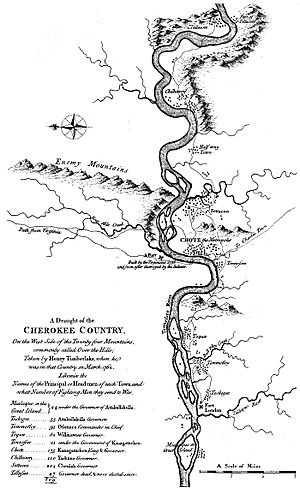
When Dragging Canoe, McDonald, and their men heard about the destruction, they returned to Chickamauga. The Shawnee sent envoys and warriors to help. Dragging Canoe showed them the war belts he had accepted in 1776 and said, "We are not yet conquered." To strengthen their alliance, the Cherokee sent nearly 100 warriors north. The towns in the Chickamauga area were rebuilt. Dragging Canoe responded to the Shelby expedition with raids on North Carolina and Virginia.
In mid-summer 1779, Cameron arrived at Chickamauga and convinced 300 Cherokee to join him on a march to South Carolina. In October, Andrew Williamson's South Carolina militia attacked several towns on the eastern Cherokee frontier and burned their food supplies.
Chickasaw-American War
The Chickasaw began fighting in June 1780 when George Rogers Clark and over 500 men built Fort Jefferson near the Ohio River, inside Chickasaw hunting grounds.
The Chickasaw destroyed the settlement, besieged the fort, and attacked settlers in Kentucky. Their last raid with Dragging Canoe's Cherokee was on Freeland's Station on the Cumberland on January 11, 1781.
On April 2, 1781, the Cherokee launched their largest attack of the wars against these settlements. This led to the Battle of the Bluff, led by Dragging Canoe, which lasted until the next day. It was the last attack of this war. After this, settlers began to leave these frontier settlements until only three forts remained, a situation that lasted until 1785.
Moving to the Lower Towns
Dragging Canoe and his people moved to what white settlers called the Five Lower Towns. These towns were located downriver from natural obstacles in the 26-mile Tennessee River Gorge. These obstacles made river travel difficult.
The Five Lower Towns included Running Water, where Dragging Canoe made his headquarters; Nickajack; Long Island; Crow Town; and Stecoyee. Tuskegee Island Town was used as a lookout post.
This move was into Muscogee territory. Dragging Canoe had sent a group to meet with Alexander McGillivray, a major Muscogee leader, to get their permission. When the Cherokee moved, John McDonald, now deputy to Thomas Brown, also moved his base to Running Water.
More Cherokee continued to move west to join Dragging Canoe's group. Many were from North Georgia, fleeing attacks. Cherokee from the Middle Towns also came, establishing a town called Sawtee.
Later major settlements included Willstown, Turkeytown, Creek Path, Turnip Town, and Chatuga.
Because of the large number of people from North Georgia, Dragging Canoe's followers and others in the area became known as the Lower Cherokee. Their numbers grew with runaway slaves, white Loyalists, Muscogee, Yuchi, Natchez, and Shawnee, plus some Spanish, French, Irish, and Germans. The town of Coosada joined the group, as did a band of Chickasaw living at Ditto's Landing.
Cherokees in the North
In November 1782, representatives from four northern tribes visited Dragging Canoe at Running Water Town. They wanted his Cherokee to help attack Pittsburgh and American settlements in Kentucky and Illinois. When the group returned north, Turtle-at-Home, Dragging Canoe's brother, took 70 warriors north to fight with the Shawnee.
By early 1783, there were at least three main Cherokee communities in the north, living among the Shawnee, Wyandot-Mingo, and Munsee-Lenape. These groups remained in the northwest until after the Treaty of Greenville in 1795.
Georgia Indian War of 1782
At the end of 1781, the Cherokee and Muscogee invaded Georgia again. They were met by South Carolina and Georgia troops. The Cherokee retreated, burning their own lands to deny supplies to their enemies. The American forces eventually retreated, leaving the backcountry open to more raids.
By fall 1782, Loyalist Lt. Col. Thomas Waters and his rangers, with Cherokee and Muscogee warriors, attacked homesteads and settlements in Georgia.
South Carolina and Georgia sent a joint expedition led by Andrew Pickens and Elijah Clarke to stop this. They invaded the area, destroying thirteen towns and villages. By October 22, Waters and his men had escaped, and the Cherokee sought peace.
St. Augustine Meeting
In January 1783, Dragging Canoe and 1,200 Cherokee traveled to St. Augustine, Florida, for a meeting with other western tribes (Shawnee, Muscogee, Mohawk, Seneca, Lenape, Mingo, Tuscarora, and Choctaw). They discussed forming a group to oppose the Americans. Brown, the British Indian Superintendent, approved this idea.
A few months later, a larger council of southern tribes met. But plans for a larger group were cut short by the signing of the Treaty of Paris (1783). This treaty, signed May 30, 1783, set the northern border between Georgia and the Cherokee. The Cherokee gave up large amounts of land between the Savannah and Chattahoochee Rivers.
Overhill Politics
In fall 1783, the older, peace-seeking leaders replaced Savanukah with Corntassel as First Beloved Man. They sent messages of peace to Virginia and North Carolina, complaining about settlers moving onto their land. However, this did not stop war parties from raiding settlements in East Tennessee.
Treaty of Paris (1783)
The Treaty of Paris, signed on September 3, 1783, officially ended the American Revolution. The U.S. had already declared the fighting over in April.
After the treaty, Dragging Canoe sought support from the Spanish, who still claimed land south of the Cumberland River. He traded through Pensacola and Mobile. Dragging Canoe also kept ties with the British governor in Detroit.
With the war over, new settlers flooded into the Overmountain areas. The Cherokee reacted by raiding. Warriors from the Middle Towns began attacking new settlements on the Pigeon and French Broad rivers. In late 1783, Major Peter Fine led a militia group that burned down the town of Cowee.
Treaties with Chickasaw and Muscogee
The Chickasaw signed the Treaty of French Lick with the United States on November 6, 1783, and never fought against them again. The Lower Cherokee were also at this meeting and seemed to agree to stop attacking the Cumberland area, as American settlements there began to grow again.
In November 1783, a pro-American group of the Lower Muscogee signed the Treaty of Augusta with Georgia. They gave up land in northern Georgia called the Oconee Country. This angered McGillivray, who wanted to keep fighting. He sent warriors to raid Georgia settlements.
After the Revolution: New Paths (1783–1788)
Spanish Alliance
Spain now controlled East and West Florida, plus other territories. To keep Americans away and regain lost lands, they armed and supplied the Southern Native Americans, encouraging them to attack frontier settlements. Through Alexander McGillivray's efforts, Spain signed the Treaty of Pensacola with the Upper Muscogee and Lower Cherokee on May 30, 1784. The Treaty of Mobile was signed with the Choctaw and Alabama on June 22, 1784. The Chickasaw refused to sign because of their treaty with the Americans. After these treaties, McDonald and Ross moved to Turkeytown to be closer to their Spanish suppliers and British traders.
In summer 1785, Running Water Town hosted a large meeting of western tribes, sponsored by Spain. The goal was to plan how to resist American settlers. Besides the Chickamauga Cherokee, the Upper Muscogee and Choctaw attended from the South. Representatives from many northern tribes also came. They all agreed to deal with the Americans as a united front. This laid the groundwork for the Western Confederacy formed the next year.
Overmountain Region
With promises of support, the Cherokee of the Lower Towns renewed raids on the Overmountain settlements that summer. These raids became more violent in the fall after an incident between a settler and a Cherokee leader. This could be seen as the start of a Southwest Indian War, fought by the Cherokee and later the Muscogee.
In May 1785, the settlements of Upper East Tennessee tried to become the "State of Franklin". They held their first assembly in December 1785. One of their main reasons was to keep their hold on the Cumberland Basin.
One of the first actions of the new State of Franklin was to sign the Treaty of Dumplin Creek on June 10, 1785. This treaty gave the State of Franklin more land south of the French Broad and Holston Rivers.
The Cherokee in the Overhill, Hill, and Valley Towns signed the Treaty of Hopewell with the United States government on November 28, 1785. They were under pressure, as settlers had spread further along the Holston and French Broad rivers.
Oconee War
In spring 1785, McGillivray held a war council about Georgian settlers moving into Oconee territory. The council decided to fight the settlers. This began the Oconee War, which lasted from May 1785 to September 1794.
Georgia officials signed a new treaty with some Lower Muscogee chiefs, who gave up land between the Altamaha and St. Mary's Rivers. This land was called the Tallassee Country.
Houston County, Georgia
After the Hopewell Treaty, Georgia created Houston County in the Great Bend of the Tennessee River. This was a joint project with the State of Franklin. In December 1785, Valentine Sevier and 90 men built a settlement and fort near what is now South Pittsburg, Tennessee.
This location was between Nickajack and Long Island towns of the Chickamauga-Lower Cherokee. By mid-January 1786, the settlers gave up due to constant fighting. The Houston County project failed. To prevent this from happening again, the Cherokee built the town of Crowmocker.
Spanish Plans
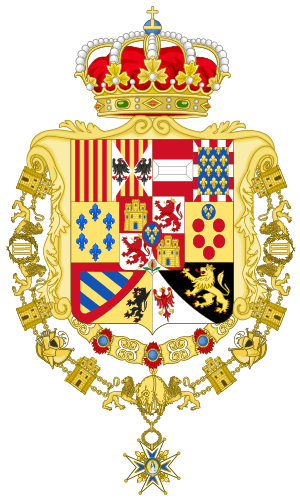
Starting in 1786, leaders from the State of Franklin and the Cumberland District secretly talked with Esteban Rodríguez Miró, the Spanish governor of Louisiana. They wanted their regions to join the Spanish Empire. People involved included James Robertson and John Sevier.
It was ironic because Spain supported the Cherokee and Muscogee who were attacking these territories. The conspiracy went so far that Franklin and Cumberland officials promised to swear loyalty to Spain. They hoped this would stop the Native American attacks.
Cherokee War of 1786
Conflict grew because of unhappiness with the Treaty of Hopewell, fueled by Dragging Canoe. In the east, Overhill and Valley Town warriors fought Franklin. In the west, the Lower Towns raided the Cumberland. Cherokee warriors from the Lower Towns raided Franklin settlements in spring 1786. They attacked a homestead near White's Fort (Knoxville, Tennessee) on July 20. Throughout summer 1786, Dragging Canoe and his warriors, with many Muscogee, raided the Cumberland region and Kentucky.
Sevier responded by driving off the raiders from the Holston. He then marched to Coyatee and burned its crops and council house. Sevier also led another expedition to attack the Valley Towns. This led to the Treaty of Coyatee on August 3, 1786. In this treaty, the State of Franklin forced Cherokee leaders to give up more land.
Western Confederacy Forms
A large group of Cherokee, led by The Glass, attended a major meeting of western tribes from November 28 to December 18, 1786. This meeting was in Upper Sandusky, near Detroit. British agents were present.
This meeting, started by Joseph Brant, a Mohawk leader who fought with the British, led to the creation of the Western Confederacy. This group aimed to resist American settlers in the Old Northwest. Dragging Canoe and his Cherokee were full members. The Confederacy's goal was to coordinate attacks and defense in the Northwest Indian War (1785–1795). The Northwest Ordinance in 1787, which gave away the land where these tribes lived, made them even more angry.
Trouble with Franklin and Kentucky
In early 1787, American settlers moved onto Cherokee lands so much that the Overhill Towns considered leaving their homes. They decided to stay, but this crisis led to more small raids. The situation for the Overhill Cherokee was so bad that some fled to Muscogee towns. The Chickasaw even threatened to break their treaty if something wasn't done.
The Lower Towns Cherokee, as part of the Confederacy, focused most of their efforts on Kentucky. A Kentucky militia attack mistakenly hit an Overhill hunting party, killing several members. The Kentuckians warned the Overhill Towns to control Dragging Canoe's warriors or face widespread revenge.
Coldwater Indian War (1785–1787)

Around 1785, Cherokee and Muscogee warriors gathered in Coldwater town and attacked American settlements along the Cumberland River. The fighting group included about 9 Frenchmen, 35 Cherokee, and 10 Muscogee. Because the town was hidden, James Robertson, commander of the Cumberland militia, at first blamed the Lower Cherokee. In 1787, he marched his men to their borders but did not attack. He sent a peace offer to Running Water. Dragging Canoe sent a group to Nashville to explain that his Cherokee were not responsible. Meanwhile, the attacks continued.
Two Chickasaw hunters found Coldwater Town and told their leader, Piomingo. Piomingo sent messengers to Nashville. Just after they arrived, a war party attacked an outlying settlement, killing Robertson's brother. In response, Robertson gathered 150 volunteers and attacked Coldwater Town. They surprised the town, chasing its defenders to the river and killing about half of them. They took all the trade goods, burned the town, and left.
Cherokee Influence Grows (1788–1792)
Cherokee-Franklin War (1788–1789)
The conflict between the Cherokee and Americans in the State of Franklin became very bloody and widespread from late spring 1788 into the next year. A key part of this conflict was the large number of Muscogee warriors fighting with Cherokee groups.
Attacks on Families
In May 1788, a Cherokee group from Chilhowee attacked John Kirk's family home. When Kirk and his oldest son returned, they found eleven other family members dead. This started a series of Cherokee raids across the region, causing settlers to hide in forts.

In May 1788, James Brown's family was traveling by boat to the Cumberland. When they passed Williams Island in Chattanooga, Bloody Fellow stopped them. He let them go but sent messengers ahead to Running Water.
At Nickajack, a group of 40 warriors led by John Vann boarded the boat. They killed Colonel Brown, his two older sons, and five other young men. Mrs. Brown, her two younger sons, and three daughters were taken prisoner and given to different families. The Breath, Nickajack's headman, was angry when he heard about the killings. He later adopted Joseph, one of Brown's sons. Mrs. Brown and one daughter were given to the Muscogee and ended up with Alex McGillivray.
Franklinite Invasion
In June 1788, John Sevier, no longer governor of Franklin, gathered 100 volunteers and went to the Overhill Towns. They burned Great Hiwassee and Tallasee.
Returning to Chota, Sevier sent a group to Chilhowee to punish those responsible for the Kirk family killings. This group included John Kirk Jr. They brought Corntassel and Hanging Man from Chota. At Chilhowee, they raised a flag of truce and took Corntassel and Hanging Man to Abraham's house. Guards were placed at the doors and windows, and John Kirk Jr. was given a tomahawk to get his revenge.
The murder of these peaceful Overhill chiefs under a flag of truce angered the entire Cherokee nation. Even men who had been hesitant joined the fighting. This increased hostility for several months. Doublehead, Corntassel's brother, was especially furious. Cherokee from the Overhill Towns and a large number of Muscogee warriors joined the Lower Towns in fighting.
Dragging Canoe spoke to the general council of the Nation, which had moved to Ustanali. The council elected Little Turkey as First Beloved Man to replace the murdered chief.
Siege of Houston's Station
In August 1788, the commander at Houston's Station (near Maryville, Tennessee) learned that nearly 500 Cherokee were planning to attack. He sent a patrol to the Overhill Towns.
The patrol stopped in the deserted town of Citico. While gathering fruit, six of them were killed in an ambush, and ten more died trying to escape.
With these losses, Houston's Station was in trouble. Only the arrival of John Sevier's relief force saved the fort. Sevier then marched to the Little Tennessee and burned Chilhowee.
Attempted Invasion of Lower Towns
Later in August, Joseph Martin, with 500 men, marched toward the Chickamauga area. He sent a group to secure a pass over Lookout Mountain, but they were ambushed and defeated by a large group of Dragging Canoe's warriors. Dragging Canoe, John Watts, Bloody Fellow, and other leaders were present.
Dragging Canoe raised an army of 3,000 Cherokee warriors, splitting them into smaller, flexible groups. One group was led by John Watts.
Battles at Stations
In October 1788, Watts' group attacked Gillespie's Station on the Holston River. They captured settlers working in fields and then stormed the fort, killing men and some women, and taking 28 women and children prisoner. They then attacked White's Fort and Houston's Station but were driven back.
Another large group attacked Sherrill's Station but was driven off by Sevier. In response, settlers increased their attacks. Sevier's troops invaded the Middle and Valley Towns in North Carolina.
Bob Benge and his warriors helped people escape from Ustalli. After burning the town, Sevier's group chased the fleeing inhabitants and were ambushed by Benge's party.
U.S. soldiers burned cornfields in Coota-cloo-hee but were chased off by 400 warriors led by Watts. Watts' army followed Sevier's back to the Franklin settlements, attacking randomly. As a result, the Overhill Cherokee and refugees left most of their settlements on the Little Tennessee. Chota was one of the few Overhill towns left with many people.
Council at Coweta
On March 2, 1789, the Lower Muscogee chief town of Coweta hosted a council between the Muscogee and Cherokee. Dragging Canoe and Hanging Maw led the Cherokee. They agreed they trusted neither Americans nor Spanish. They wrote a letter to the British king, promising loyalty for direct help. Nothing came of this request.
Prisoner Exchange
John Watts' group faced a major defeat in January 1789. They were surrounded by John Sevier's force. Watts' group lost nearly 150 warriors.
News of their defeat reached Running Water in April, along with an offer from Sevier for a prisoner exchange, specifically mentioning the surviving members of the Brown family, including Joseph. Among those captured were Bloody Fellow and Little Turkey's daughter.
Joseph and his sister Polly were brought to Running Water. When runners went to Crow Town for their youngest sister, Jane, her owner refused to give her up. Bob Benge rode to Crow Town and returned with Jane. The three children were given to Sevier on April 20. Mrs. Brown and Elizabeth were later given to her son William. George, another surviving son, stayed with the Muscogee until 1798.
Non-Treaty of Swannanoa
On May 25, 1789, the Cherokee were supposed to sign a peace treaty with the United States. The Cherokee leaders never showed up. However, when Americans met Cherokee on their way to meet the Muscogee, they were assured that fighting was over.
Doublehead's War
In 1790, a group of about 40 warriors led by Doublehead settled at Muscle Shoals. His town was diverse, with Cherokee, Muscogee, Shawnee, and some Chickasaw. It quickly grew and carried out many small raids on settlers in the Cumberland and Kentucky. In June 1792, his warriors ambushed a canoe carrying three sons of Valentine Sevier (John Sevier's brother) and three others, killing the three Seviers.
Doublehead often acted independently but sometimes joined larger operations with the Lower Cherokee, such as invasions of the Cumberland in 1792 and the Holston in 1793.
Treaty of New York (1790)
Dragging Canoe's ally, Alex McGillivray, led a group of Muscogee leaders to sign the Treaty of New York (1790) in August 1790 with the United States. McGillivray, who was made an American general, gave up the Oconee Country. In return, the U.S. government recognized Muscogee rights to the Tallassee Country.
This treaty was meant to end the Oconee War, but it angered American settlers who were removed from the Tallassee Country and Muscogee who wanted to keep the Oconee Country. So, the war continued. The treaty also marked the decline of McGillivray's influence. By mid-1791, another leader, William Augustus Bowles, had enough influence to send large war parties to raid the Cumberland again, despite the treaty.
Muscle Shoals Settlement
In January 1791, a group of land speculators tried to take control of Muscle Shoals by building a settlement and fort. They did this against President Washington's orders. The Glass came from Running Water with 60 warriors and told them to leave immediately or be killed. He then burned their blockhouse as they left.
Bob Benge's War
Starting in 1791, Benge and his brother The Tail, based at Willstown, began leading attacks against settlers in East Tennessee, Southwest Virginia, and Kentucky. They often worked with Doublehead. Benge became one of the most feared warriors on the frontier.
Treaty of Holston (1791)
The Treaty of Holston, signed in July 1791, required the Upper Towns to give up more land for peace. This was because the U.S. government could not stop illegal settlements. Several Lower Cherokee leaders, including John Watts, Doublehead, and Bloody Fellow, signed the treaty.
Battle of the Wabash
Later in summer, a small group of Cherokee, led by Dragging Canoe's brother Little Owl, traveled north to meet with leaders of the Western Confederacy. They learned that Governor Arthur St. Clair was planning an invasion. Little Owl sent word south to Running Water.
Dragging Canoe quickly sent 30 warriors north, led by his brother The Badger. They joined Little Owl and Turtle-at-Home and fought in the Battle of the Wabash in November 1791. This was the worst defeat ever for the American military against Native Americans.
After the battle, Little Owl, The Badger, and Turtle-at-Home returned south with most of their warriors. They brought back 30 Shawnee warriors who often fought alongside Little Owl's group.
Dragging Canoe's Death
Inspired by the northern victory, Dragging Canoe tried to unite the Native American people in his area. His visits to the Lower Muscogee and Choctaw were successful, but the Chickasaw refused. When he returned, a huge all-night celebration was held in his honor.
By the morning of March 1, 1792, Dragging Canoe was dead, possibly from exhaustion or a heart attack. His body was carried to Running Water and buried. He was remembered at the national council on June 28, 1792. Governor Blount, a leader of his enemies, said that "Dragging Canoe stood second to none in the Nation."
After the Revolution: The Watts Years (1792–1795)
At his own request, John Watts became the leader of the Lower Cherokee after Dragging Canoe's death. Bloody Fellow and Doublehead continued Dragging Canoe's policy of Native American unity. They agreed with McGillivray of the Upper Muscogee to build joint forts where warriors from both tribes could operate.
Watts, Tahlonteeskee, and 'Young Dragging Canoe' traveled to Pensacola in May at the invitation of the Spanish governor. They made a treaty with Spain for weapons and supplies. Watts then moved his base to Willstown.
Meanwhile, John McDonald, now British Indian Affairs Superintendent, moved to Turkeytown. Some older chiefs, like The Glass and The Breath, did not actively fight but did not stop warriors from their towns from joining raids.
The Trans-Appalachian communities became the Southwest Territory of the United States in 1790. Cherokee and Muscogee warriors, along with their Shawnee guests, began raiding both districts of the Southwest Territory. In April 1792, a Cherokee-Shawnee war party led by Bob Benge and Shawnee Warrior raided the Holston region. In summer 1792, a war party from Running Water joined them. On June 26, they destroyed Zeigler's Station in Sumner County. This led Governor James Robertson to call up troops to guard the region.
Invasion of the Mero District
On September 7 or 8, 1792, a Cherokee council at Running Water formally declared war against the United States. Watts planned a large attack on the Washington District. But when he learned his plan was expected, he decided to attack the Mero District instead. Watts led an army of nearly 1,000 warriors, including cavalry.
On the evening of September 30, Watts' force attacked Buchanan's Station, a small fort. The attack was a disaster for Watts. Watts was wounded, and many of his best leaders were killed, including Talotiskee, Shawnee Warrior, and Dragging Canoe's brother Little Owl.
Doublehead's group ambushed a party and then headed toward Nashville. They were attacked by militia and lost 13 men. Tahlonteeskee's group attacked Black's Station, killing three and capturing horses. Middle Striker's group ambushed a large armed force, defeating them without losing any men.
In revenge for the deaths at Buchanan's Station, Benge, Doublehead, and his brother Pumpkin Boy led a group of 60 into southwestern Kentucky in early 1793.
Spring and Summer Campaigns, 1793
A group of Muscogee warriors began attacking isolated farms. This group continued to harass the Holston settlements until summer 1794. Warriors from the Upper Towns and some from the Overhill and Valley Towns also raided the eastern districts in spring and summer 1793.
In the Mero District, two groups attacked Bledsoe's Station and Greenfield Station in April 1793. Another group attacked Hays' Station in June. In August, the Coushatta raided the area around Clarksville, Tennessee, attacking the Baker family and taking one prisoner who was later ransomed.
Peace Talks
Watts sent envoys to Knoxville, the capital of the Southwest Territory, to meet with Governor William Blount to discuss peace. The group included Bob McLemore, Tahlonteeskee, Captain Charley, and Doublehead. They met on February 4, 1793, and Blount invited the Lower Cherokee to send a group to Philadelphia to meet with President Washington.
The meeting in Philadelphia was set for June 1793. On their way, the Cherokee group stopped in Coyatee because Hanging Maw and other chiefs from the Upper Towns were also going. A large group of Lower Cherokee had been raiding the Upper East, killing two men and stealing horses. On their way out, they passed through Coyatee, and a pursuit party tracked them there.
The militia violated orders by crossing the Little Tennessee, the border. They fired without warning. In the chaos, 11 leading men were killed, including Captain Charley. Several were wounded, including Hanging Maw, his wife and daughter, Doublehead, and Tahlonteeskee. One white delegate was also killed. The Cherokee agreed to wait for the trial of the person responsible. The trial was unfair, partly because John Beard, the person responsible, was a close friend of John Sevier.
Invasion of the Eastern Districts
Watts responded to Beard's acquittal by invading the Holston area with over 1,000 Cherokee and Muscogee, plus some Shawnee. They planned to attack Knoxville.
In August, Watts attacked Henry's Station with 200 men but retreated after heavy gunfire from the fort. The four groups of warriors met a month later and moved toward Knoxville. Along the way, Cherokee leaders discussed whether to kill all inhabitants of Knoxville or just the men. James Vann argued for saving women and children, while Doublehead argued for killing everyone.
Further on, they found a small settlement called Cavett's Station on September 25, 1793. After surrounding the place, Benge negotiated with the settlers, promising to spare their lives if they surrendered. However, after the settlers walked out, Doublehead's group and his Muscogee allies attacked and began killing them, despite pleas from Benge and others. Vann managed to save one small boy, but Doublehead killed him. Watts saved another young boy, giving him to Vann, who later gave him to three Muscogee for safety. One of the Muscogee chiefs killed that boy a few days later.
Because of this incident, Vann called Doublehead "Babykiller" for the rest of his life. This also started a long feud that shaped Cherokee politics in the early 1800s and ended with Doublehead's death in 1807. By this time, tensions among the Cherokee caused the force to break up, with the main group heading south.
Battle of Hightower
Sevier countered the invasion by occupying Ustanali, which was deserted. He and his men then followed the Cherokee-Muscogee force south to Etowah. This led to the "Battle of Hightower" on October 17, 1793. Sevier's force defeated their opponents and then destroyed several Cherokee villages before returning to the Southwest Territory. This battle was the last major battle of the wars between the Cherokee and American frontier people.
Spring and Summer 1794
Between January and September 1794, there were over forty raids by Cherokee and Muscogee war parties on the Mero District, mostly by Doublehead. These raids led to the Nickajack Expedition in September, which finally ended the Cherokee–American wars.
Meanwhile, Bob Benge attacked Washington District and Southwest Virginia. He was killed on April 6, 1794. His red-haired scalp was sent to Governor Henry Lee III. Benge was not alone in raiding the Eastern Districts. Many horses were stolen, and a family was killed.
Frustrated with the governor's calls for peace, John Beard organized 150 men and attacked the Hiwasee Towns, burning two and killing several Cherokee. George Doherty's militia also attacked Great Tellico, burning it, and then burned at least two towns and crops in the Valley Towns.
On June 9, 1794, a Cherokee group attacked a river party at Muscle Shoals. They killed the white passengers, looted goods, and took African-American slaves captive.
On June 26, 1794, the U.S. government and the Cherokee signed the Treaty of Philadelphia. This treaty mostly confirmed earlier land agreements. Both Doublehead and Bloody Fellow signed it.
End of Lesley's War Party
In July 1794, Hanging Maw sent his men with Holston volunteers to chase Lesley's Muscogee war party. They killed two and handed a third to the whites for trial and execution. Two days later, a small Muscogee war party crossed the Tennessee River. Hanging Maw's warriors joined federal troops in pursuit and defeated them. However, other Muscogee war parties continued to attack the Holston frontier for the rest of the month.
Nickajack Expedition and Peace Treaty
To end the wars, Robertson sent U.S. troops, militia, and Kentucky volunteers to the Five Lower Towns. Led by Major James Ore and guided by locals like Joseph Brown, Ore's army attacked Nickajack on September 13, killing many inhabitants. After burning the houses, the soldiers went upriver and burned Running Water. Joseph Brown tried to save women and children. The Cherokee casualties were not very high, as most people from both towns were at Willstown for a major stickball game.
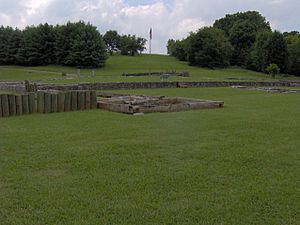
Watts finally decided to call for peace. He was discouraged by the destruction of the two towns, Bob Benge's death, and the recent defeat of the Western Confederacy by General "Mad Anthony" Wayne's army at the Battle of Fallen Timbers. Over 100 Cherokee had fought there. The loss of Spanish support also convinced Watts to end the fighting.
On November 7, 1794, he made the Treaty of Tellico Blockhouse. This treaty was important because it did not require the Cherokee to give up any more land, only to recognize earlier land agreements. This led to a period of relative peace into the 19th century.
The Muscogee continued fighting after Nickajack and Running Water were destroyed and the Lower Cherokee made peace. In October 1794, they attacked Bledsoe's Station again. In November, they attacked Sevier's Station, killing fourteen people.
In December 1794, Cherokee warriors from the Upper Towns stopped a Muscogee campaign against Georgia settlements and warned them to stop attacking the Southwest Territory. In early January 1795, the Chickasaw began killing Muscogee warriors in Middle Tennessee, as allies of the United States. So, in March, the Muscogee began to focus their attacks on the Chickasaw instead of the Cumberland.
Aftermath
After the peace treaty, leaders from the Lower Cherokee became very important in national affairs. When the Cherokee Nation government was formed, the first three Principal Chiefs—Little Turkey, Black Fox, and Pathkiller—had all been warriors under Dragging Canoe. The first two Speakers of the Cherokee National Council, Doublehead and Turtle-at-Home, also fought with Dragging Canoe.
The influence of these former warriors from the Lower Towns continued into the 1800s. Even later, when younger chiefs from the Upper Towns became powerful, many of them had also fought with Dragging Canoe and Watts.
Because of the ongoing conflicts, the United States placed one of its two permanent military forts at Fort Southwest Point, where the Tennessee and Clinch Rivers meet. The other was at Fort Pitt in Pennsylvania.
|


